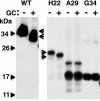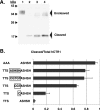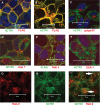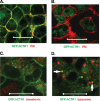Human copper transporter 1 lacking O-linked glycosylation is proteolytically cleaved in a Rab9-positive endosomal compartment
- PMID: 19684018
- PMCID: PMC2788861
- DOI: 10.1074/jbc.M109.044925
Human copper transporter 1 lacking O-linked glycosylation is proteolytically cleaved in a Rab9-positive endosomal compartment
Abstract
The human copper transporter hCTR1 is a homotrimer composed of a plasma membrane protein of 190 amino acids that contains three transmembrane segments. The extracellular 65-amino acid amino terminus of hCTR1 contains both N-linked (at Asn(15)) and O-linked (at Thr(27)) sites of glycosylation. If O-glycosylation at Thr(27) is prevented, hCTR1 is efficiently cleaved, removing approximately 30 amino acids from the amino terminus. We have now investigated (i) the site of this cleavage, determining which peptide bonds are cleaved, (ii) the mechanism by which glycosylation prevents cleavage, and (iii) where in the cell the proteolytic cleavage takes place. Cleavage occurs in the sequence Ala-Ser-His-Ser-His (residues 29-33), which does not contain previously recognized protease cleavage sites. Using a series of hCTR1 mutants, we show that cleavage occurs preferentially between residues Ala(29)-Ser(30)-His(31). We also show that the O-linked polysaccharide at Thr(27) blocks proteolysis due to its proximity to the cleavage site. Moving the cleavage site away from the Thr(27) polysaccharide by insertion of as few as 5 amino acids allows cleavage to occur in the presence of glycosylation. Imaging studies using immunofluorescence in fixed cells and a functional green fluorescent protein-tagged hCTR1 transporter in live cells showed that the cleaved peptide accumulates in punctate structures in the cytoplasm. These puncta overlap compartments were stained by Rab9, indicating that hCTR1 cleavage occurs in a late endosomal compartment prior to delivery of the transporter to the plasma membrane.
Figures











Similar articles
-
Rate and regulation of copper transport by human copper transporter 1 (hCTR1).J Biol Chem. 2013 Jun 21;288(25):18035-46. doi: 10.1074/jbc.M112.442426. Epub 2013 May 8. J Biol Chem. 2013. PMID: 23658018 Free PMC article.
-
O-linked glycosylation at threonine 27 protects the copper transporter hCTR1 from proteolytic cleavage in mammalian cells.J Biol Chem. 2007 Jul 13;282(28):20376-87. doi: 10.1074/jbc.M701806200. Epub 2007 May 24. J Biol Chem. 2007. PMID: 17525160
-
Molecular characterization of hCTR1, the human copper uptake protein.J Biol Chem. 2002 Aug 9;277(32):29162-71. doi: 10.1074/jbc.M203652200. Epub 2002 May 28. J Biol Chem. 2002. PMID: 12034741
-
The mechanism of copper uptake mediated by human CTR1: a mutational analysis.J Biol Chem. 2005 Nov 4;280(44):37159-68. doi: 10.1074/jbc.M508822200. Epub 2005 Aug 31. J Biol Chem. 2005. PMID: 16135512
-
The N-terminus of the human copper transporter 1 (hCTR1) is localized extracellularly, and interacts with itself.Biochem J. 2003 Mar 15;370(Pt 3):881-9. doi: 10.1042/BJ20021128. Biochem J. 2003. PMID: 12466020 Free PMC article.
Cited by
-
Rate and regulation of copper transport by human copper transporter 1 (hCTR1).J Biol Chem. 2013 Jun 21;288(25):18035-46. doi: 10.1074/jbc.M112.442426. Epub 2013 May 8. J Biol Chem. 2013. PMID: 23658018 Free PMC article.
-
Model peptides provide new insights into the role of histidine residues as potential ligands in human cellular copper acquisition via Ctr1.J Am Chem Soc. 2011 Mar 30;133(12):4427-37. doi: 10.1021/ja108890c. Epub 2011 Mar 4. J Am Chem Soc. 2011. PMID: 21375246 Free PMC article.
-
Polymorphic transporters and platinum pharmacodynamics.Drug Metab Pharmacokinet. 2013;28(1):19-27. doi: 10.2133/dmpk.dmpk-12-rv-073. Epub 2012 Sep 18. Drug Metab Pharmacokinet. 2013. PMID: 22986709 Free PMC article. Review.
-
Characterization of a monoclonal antibody capable of reliably quantifying expression of human Copper Transporter 1 (hCTR1).J Trace Elem Med Biol. 2014 Apr;28(2):151-159. doi: 10.1016/j.jtemb.2013.12.003. Epub 2013 Dec 18. J Trace Elem Med Biol. 2014. PMID: 24447817 Free PMC article.
-
Global Mapping of O-Glycosylation of Varicella Zoster Virus, Human Cytomegalovirus, and Epstein-Barr Virus.J Biol Chem. 2016 Jun 3;291(23):12014-28. doi: 10.1074/jbc.M116.721746. Epub 2016 Apr 15. J Biol Chem. 2016. PMID: 27129252 Free PMC article.
References
-
- Petris M. J. (2004) Pflugers Arch. 447, 752–755 - PubMed
-
- Linder M. C., Wooten L., Cerveza P., Cotton S., Shulze R., Lomeli N. (1998) Am. J. Clin. Nutr. 67, Suppl. 5, 965S–971S - PubMed
-
- Maryon E. B., Molloy S. A., Zimnicka A. M., Kaplan J. H. (2007) Biometals 20, 355–364 - PubMed
-
- Kim B. E., Nevitt T., Thiele D. J. (2008) Nat. Chem. Biol. 4, 176–185 - PubMed
-
- Huffman D. L., O'Halloran T. V. (2001) Annu. Rev. Biochem. 70, 677–701 - PubMed
Publication types
MeSH terms
Substances
Grants and funding
LinkOut - more resources
Full Text Sources
Molecular Biology Databases
Research Materials

